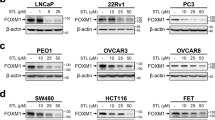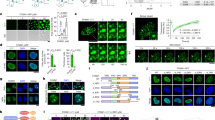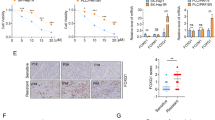Abstract
Forkhead box O3 (FOXO3) is a multispecific transcription factor that is responsible for multiple and conflicting transcriptional programs such as cell survival and apoptosis. The protein is heavily post-translationally modified and there is considerable evidence that post-transcriptional modifications (PTMs) regulate protein stability and nuclear–cytosolic translocation. Much less is known about how FOXO3 PTMs determine the specificity of its transcriptional program. In this study we demonstrate that exposure of hepatocytes to ethanol or exposure of macrophages to lipopolysaccharide (LPS) induces the c-Jun N-terminal kinase (JNK)-dependent phosphorylation of FOXO3 at serine-574. Chromatin immunoprecipitation (ChIP), mRNA and protein measurements demonstrate that p-574-FOXO3 selectively binds to promoters of pro-apoptotic genes but not to other well-described FOXO3 targets. Both unphosphorylated and p-574-FOXO3 bound to the B-cell lymphoma 2 (Bcl-2) promoter, but the unphosphorylated form was a transcriptional activator, whereas p-574-FOXO3 was a transcriptional repressor. The combination of increased TRAIL (TNF-related apoptosis-inducing ligand) and decreased Bcl-2 was both necessary and sufficient to induce apoptosis. LPS treatment of a human monocyte cell line (THP-1) induced FOXO3 S-574 phosphorylation and apoptosis. LPS-induced apoptosis was prevented by knockdown of FOXO3. It was restored by overexpressing wild-type FOXO3 but not by overexpressing a nonphosphorylatable S-574A FOXO3. Expression of an S-574D phosphomimetic form of FOXO3 induced apoptosis even in the absence of LPS. A similar result was obtained with mouse peritoneal macrophages where LPS treatment increased TRAIL, decreased Bcl-2 and induced apoptosis in wild-type but not FOXO3−/− cells. This work thus demonstrates that S-574 phosphorylation generates a specifically apoptotic form of FOXO3 with decreased transcriptional activity for other well-described FOXO3 functions.
Similar content being viewed by others
Log in or create a free account to read this content
Gain free access to this article, as well as selected content from this journal and more on nature.com
or
Abbreviations
- FOXO3:
-
forkhead box O3
- PTM:
-
post-transcriptional modification
- LPS:
-
lipopolysaccharide
- ChIP:
-
chromatin immunoprecipitation
- TRAIL:
-
TNF-related apoptosis-inducing ligand
- Bcl-2:
-
B-cell lymphoma 2
- PrxIII:
-
peroxiredoxin III
- SOD2:
-
superoxide dismutase 2
- Bim:
-
B-cell lymphoma 2 interacting mediator of cell death
- TUNEL:
-
terminal deoxynucleotidyl transferase dUTP nick end labeling
- LDH:
-
lactate dehydrogenase
- JNK:
-
c-Jun N-terminal kinase
- PUMA:
-
p53 upregulated modulator of apoptosis
- Noxa:
-
phorbol-12-myristate-13-acetate-induced protein 1
- ADH:
-
alcohol dehydrogenase
- HCV:
-
hepatitis C virus
References
Sedding DG . FoxO transcription factors in oxidative stress response and ageing—a new fork on the way to longevity? Biol Chem 2008; 389: 279–283.
van der Horst A, Burgering BM . Stressing the role of FoxO proteins in lifespan and disease. Nat Rev Mol Cell Biol 2007; 8: 440–450.
Dijkers PF, Medema RH, Pals C, Banerji L, Thomas NS, Lam EW et al. Forkhead transcription factor FKHR-L1 modulates cytokine-dependent transcriptional regulation of p27(KIP1). Mol Cell Biol 2000; 20: 9138–9148.
Tran H, Brunet A, Grenier JM, Datta SR, Fornace AJ Jr, DiStefano PS et al. DNA repair pathway stimulated by the forkhead transcription factor FOXO3a through the Gadd45 protein. Science 2002; 296: 530–534.
Chung YW, Kim HK, Kim IY, Yim MB, Chock PB . Dual function of protein kinase C (PKC) in 12-O-tetradecanoylphorbol-13-acetate (TPA)-induced manganese superoxide dismutase (MnSOD) expression: activation of CREB and FOXO3a by PKC-alpha phosphorylation and by PKC-mediated inactivation of Akt, respectively. J Biol Chem 2011; 286: 29681–29690.
Hagenbuchner J, Kuznetsov A, Hermann M, Hausott B, Obexer P, Ausserlechner MJ . FOXO3-induced reactive oxygen species are regulated by BCL2L11 (Bim) and SESN3. J Cell Sci 2012; 125: 1191–1203.
Calnan DR, Brunet A . The FoxO code. Oncogene 2008; 27: 2276–2288.
Brunet A, Bonni A, Zigmond MJ, Lin MZ, Juo P, Hu LS et al. Akt promotes cell survival by phosphorylating and inhibiting a Forkhead transcription factor. Cell 1999; 96: 857–868.
Yang JY, Zong CS, Xia W, Yamaguchi H, Ding Q, Xie X et al. ERK promotes tumorigenesis by inhibiting FOXO3a via MDM2-mediated degradation. Nat Cell Biol 2008; 10: 138–148.
Su JL, Cheng X, Yamaguchi H, Chang YW, Hou CF, Lee DF et al. FOXO3a-dependent mechanism of E1A-induced chemosensitization. Cancer Res 2011; 71: 6878–6887.
Yoo H, Lee YS, Lee S, Kim S, Kim TY . Pachastrissamine from Pachastrissa sp. inhibits melanoma cell growth by dual inhibition of Cdk2 and ERK-mediated FOXO3 downregulation. Phytother Res 2012; 26: 1927–1933.
van der Horst A, de Vries-Smits AM, Brenkman AB, van Triest MH, van den Broek N, Colland F et al. FOXO4 transcriptional activity is regulated by monoubiquitination and USP7/HAUSP. Nat Cell Biol 2006; 8: 1064–1073.
Lehtinen MK, Yuan Z, Boag PR, Yang Y, Villén J, Becker EB et al. A conserved MST-FOXO signaling pathway mediates oxidative-stress responses and extends life span. Cell 2006; 125: 987–1001.
Davila D, Connolly NM, Bonner H, Weisová P, Dussmann H, Concannon CG et al. Two-step activation of FOXO3 by AMPK generates a coherent feed-forward loop determining excitotoxic cell fate. Cell Death Differ 2012; 19: 1677–1688.
Essers MA, Weijzen S, de Vries-Smits AM, Saarloos I, de Ruiter ND, Bos JL et al. FOXO transcription factor activation by oxidative stress mediated by the small GTPase Ral and JNK. EMBO J 2004; 23: 4802–4812.
Yamagata K, Daitoku H, Takahashi Y, Namiki K, Hisatake K, Kako K et al. Arginine methylation of FOXO transcription factors inhibits their phosphorylation by Akt. Mol Cell 2008; 32: 221–231.
Brunet A, Sweeney LB, Sturgill JF, Chua KF, Greer PL, Lin Y et al. Stress-dependent regulation of FOXO transcription factors by the SIRT1 deacetylase. Science 2004; 303: 2011–2015.
Tikhanovich I, Cox J, Weinman SA . Forkhead box class O transcription factors in liver function and disease. J Gastroenterol Hepatol 2013; 28: 125–131.
Tseng AH, Wu LH, Shieh SS, Wang DL . SIRT3 interactions with FOXO3 acetylation, phosphorylation and ubiquitinylation mediate endothelial cell responses to hypoxia. Biochem J 2014; 464: 157–168.
Wang F, Chan CH, Chen K, Guan X, Lin HK, Tong Q . Deacetylation of FOXO3 by SIRT1 or SIRT2 leads to Skp2-mediated FOXO3 ubiquitination and degradation. Oncogene 2012; 31: 1546–1557.
Eijkelenboom A, Mokry M, de Wit E, Smits LM, Polderman PE, van Triest MH et al. Genome-wide analysis of FOXO3 mediated transcription regulation through RNA polymerase II profiling. Mol Syst Biol 2013; 9: 638.
Keniry M, Mokry M, de Wit E, Smits LM, Polderman PE, van Triest MH et al. Survival factor NFIL3 restricts FOXO-induced gene expression in cancer. Genes Dev 2013; 27: 916–927.
Tikhanovich I, Kuravi S, Campbell RV, Kharbanda KK, Artigues A, Villar MT et al. Regulation of FOXO3 by phosphorylation and methylation in hepatitis C virus infection and alcohol exposure. Hepatology 2014; 59: 58–70.
LeBlanc HN., Ashkenazi A . Apo2L/TRAIL and its death and decoy receptors. Cell Death Differ 2003; 10: 66–75.
Feldmann G . Liver apoptosis. J Hepatol 1997; 26 (Suppl 2): S1–S11.
Skopelitou A, Hadjiyannakis M, Alexopoulou V, Krikoni O, Kamina S, Agnantis N et al. Topographical immunohistochemical expression of bcl-2 protein in human liver lesions. Anticancer Res 1996; 16: 975–978.
Thurman RG II . Alcoholic liver injury involves activation of Kupffer cells by endotoxin. Am J Physiol 1998; 275: G605–G611.
Zhang X, Tang N, Hadden TJ, Rishi AK . Akt, FoxO and regulation of apoptosis. Biochim Biophys Acta 2011; 1813: 1978–1986.
Burgering BM, Medema RH . Decisions on life and death: FOXO Forkhead transcription factors are in command when PKB/Akt is off duty. J Leukoc Biol 2003; 73: 689–701.
You H, Pellegrini M, Tsuchihara K, Yamamoto K, Hacker G, Erlacher M et al. FOXO3a-dependent regulation of Puma in response to cytokine/growth factor withdrawal. J Exp Med 2006; 203: 1657–1663.
Obexer P, Geiger K, Ambros PF, Meister B, Ausserlechner MJ . FKHRL1-mediated expression of Noxa and Bim induces apoptosis via the mitochondria in neuroblastoma cells. Cell Death Differ 2007; 14: 534–547.
Tumurbaatar B, Tikhanovich I, Li Z, Ren J, Ralston R, Kuravi S et al. Hepatitis C and alcohol exacerbate liver injury by suppression of FOXO3. Am J Pathol 2013; 183: 1803–1814.
Greer EL, Brunet A . FOXO transcription factors at the interface between longevity and tumor suppression. Oncogene 2005; 24: 7410–7425.
Schips TG, Wietelmann A, Höhn K, Schimanski S, Walther P, Braun T et al. FoxO3 induces reversible cardiac atrophy and autophagy in a transgenic mouse model. Cardiovasc Res 2011; 91: 587–597.
Wilson MS, Brosens JJ, Schwenen HD, Lam EW . FOXO and FOXM1 in cancer: the FOXO-FOXM1 axis shapes the outcome of cancer chemotherapy. Curr Drug Targets 2011; 12: 1256–1266.
Xie Y, Kuravi S, Campbell RV, Kharbanda KK, Artigues A, Villar MT et al. Mechanisms of acetaminophen-induced cell death in primary human hepatocytes. Toxicol Appl Pharmacol 2014; 279: 266–274.
Miyamoto K, Araki KY, Naka K, Arai F, Takubo K, Yamazaki S et al. Foxo3a is essential for maintenance of the hematopoietic stem cell pool. Cell Stem Cell 2007; 1: 101–112.
Davies JQ, Gordon S . Isolation and culture of murine macrophages. Methods Mol Biol 2005; 290: 91–103.
Acknowledgements
This study was supported by grant AA012863 from the National Institute on Alcoholism and Alcohol Abuse, grants P20 GM103418 and P20 GM103549 from the National Institute of General Medical Sciences from the National Institutes of Health and a fellowship grant from the Biomedical Research Training Program of the University of Kansas Medical Center to ZL. The human hepatocytes used in this study were derived from samples provided by the University of Kansas Liver Center Tissue Bank. We thank Drs. Jameson Forster, Tim Schmitt and Bashar Abdulkarim for their assistance in obtaining these specimens and Dr. Michele Pritchard for helpful discussions. Supplementary Information accompanies this paper on Cell Death and Differentiation website (http://www.nature.com/cdd).
Author information
Authors and Affiliations
Corresponding author
Ethics declarations
Competing interests
The authors declare no conflict of interest.
Additional information
Edited by N Chandel
Supplementary Information accompanies this paper on Cell Death and Differentiation website
Supplementary information
Rights and permissions
About this article
Cite this article
Li, Z., Zhao, J., Tikhanovich, I. et al. Serine 574 phosphorylation alters transcriptional programming of FOXO3 by selectively enhancing apoptotic gene expression. Cell Death Differ 23, 583–595 (2016). https://doi.org/10.1038/cdd.2015.125
Received:
Revised:
Accepted:
Published:
Issue date:
DOI: https://doi.org/10.1038/cdd.2015.125
This article is cited by
-
CYP2E1-dependent upregulation of SIRT7 is response to alcohol mediated metastasis in hepatocellular carcinoma
Cancer Gene Therapy (2022)
-
FoxO3 might be involved in the inflammatory response of human monocytes to lipopolysaccharide through regulating expression of toll like receptor 4
Molecular Biology Reports (2022)
-
Primed to die: an investigation of the genetic mechanisms underlying noise-induced hearing loss and cochlear damage in homozygous Foxo3-knockout mice
Cell Death & Disease (2021)
-
A combinatorial action of GmMYB176 and GmbZIP5 controls isoflavonoid biosynthesis in soybean (Glycine max)
Communications Biology (2021)
-
SIRT7 regulates hepatocellular carcinoma response to therapy by altering the p53-dependent cell death pathway
Journal of Experimental & Clinical Cancer Research (2019)



